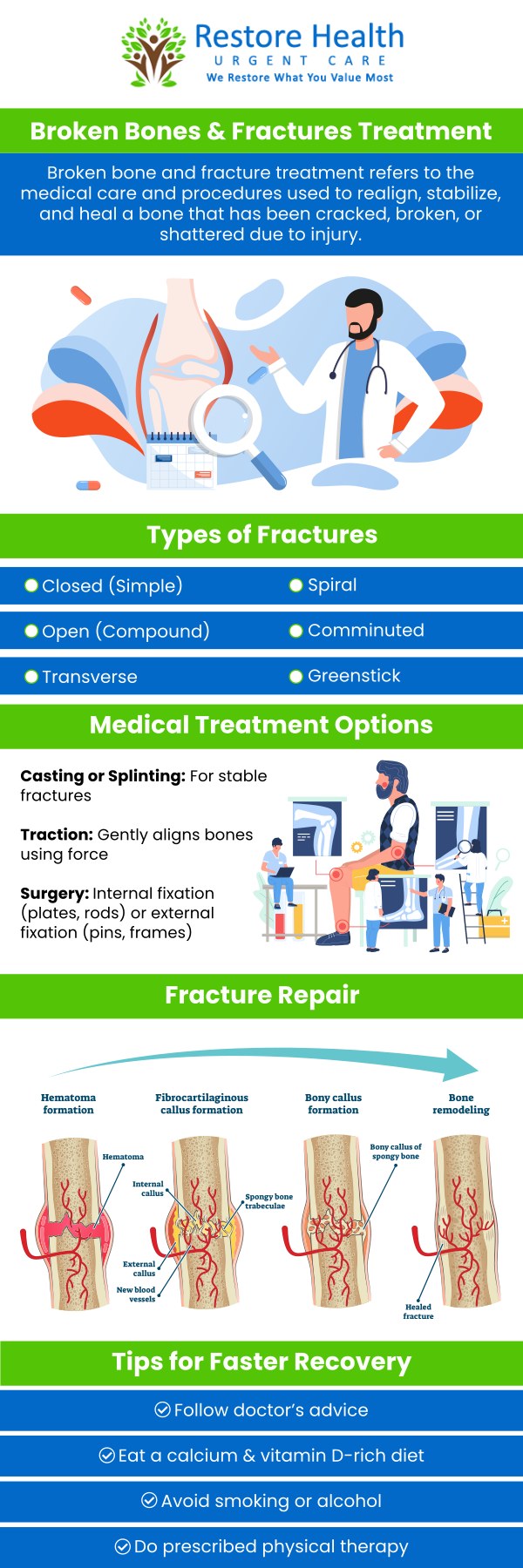Urgent Care for Bone Fracture in Palm Bay, FL
Urgent care centers provide quick and efficient treatment for bone fractures. Whether it’s a simple fracture or more complex, timely care can reduce complications and improve healing. Visit Restore our experts for a prompt diagnosis and a treatment plan tailored to your needs. For more information, contact us or schedule an appointment online. We are conveniently located at 1840 Eldron Blvd SE. Suite 1 Palm Bay, FL 32909.




Broken Bones
If you believe you have broken a bone, head into Restore Health Urgent Care today for fast and affordable treatment. Our providers can evaluate your injury and perform an X-ray to confirm a bone fracture. We have digital X-ray machines on-site for quick, convenient diagnostics.
Symptoms of a Fracture
- Intense pain in the afflicted area
- Tingling and numbness
- Immobility or limited mobility to move a limb
- Misshapen limb or joint, out–of-place appearance
- Bruising, swelling, or bleeding
If you’re suffering from any of these symptoms, simply walk into Restore Health Urgent Care. Our providers can help determine if the injury is a sprain, strain, or bone fracture, and recommend the best treatment plan.
If it is indeed a fracture, the broken bones may need to be reset into place and immobilized in a cast or splint to heal– a treatment known as reduction. Only some fractures will require reduction, yet all fractures require immobilization. Immobilizing the fracture with a cast, sling, splint, and/or brace is essential for proper healing.
Serious fractures may require surgery or devices such as pins, plates, and rods to reposition the bone. If this is the case, we can refer you to a specialist and help coordinate your care.
Broken Bones
Broken bones (also called fractures) are common injuries. The average person has two broken bones in a lifetime. Bones are built to be strong, but if a force is applied that is greater than a bone’s strength, it will break. When the bone is broken but remains inside the skin, the break is called a closed fracture. An open fracture is when the bone protrudes through the skin. Sometimes an open fracture is exposed but then goes back into the skin. This is still an open fracture, because the bone has been exposed to possible deep bone infection and must be treated for that possibility.
Depending on the way the bone breaks it’s called a displaced or non-displaced fracture. A displaced fracture is when the bone breaks into two or more parts and moves so the ends do not line up. A non-displaced fracture is when the bone breaks partially or completely, but stays together and aligned.
Who is at Risk for Broken Bones
A person’s broken bone risk depends partly on age. Childhood is a common time to experience broken bones. Children’s fractures are often less complicated than fractures in adults. Bones become more brittle as a person ages. Older people are more likely to break a bone with simple falls than young people would experience from the same type of fall.
Types of Broken Bones
Greenstick fractures are partial breaks in the bone, where the bone is actually bent. This happens most often with children, as their bones have more flexibility. Transverse fractures are when the broken bone piece is straight through, horizontally in angle to the bone. When the bone breaks in a curved or sloped manner, the break is called oblique. A comminuted fracture is when the bone is broken into many pieces. The ends of the bone are moved towards each other, the break is called a buckle fracture, or an impacted fracture. This type of break is found more often in children. When bones are weakened from disease, the break is called a pathologic fracture. Sometimes bones break with a tiny hairline crack, and these types of breaks are called stress fractures.
Severity of the Broken Bone
Location, amount of damage done, and the amount of damage done to the tissue surrounding the bone all determine the severity of the broken bone. Dangerous complications that aren’t treated correctly and immediately can lead to a more serious status of broken bone. Complications include blood vessel damage, nerve damage, infection of the bone (also called osteomyelitis,) and infection of the surrounding tissue. Recovery time is different for each individual and depends on the individual’s age, health, and type of fracture. Children with minor broken bones can be fully recovered in a matter of weeks. Adults with severe breaks like compound fractures and complications may take many months to heal.
Additional Services You May Need



